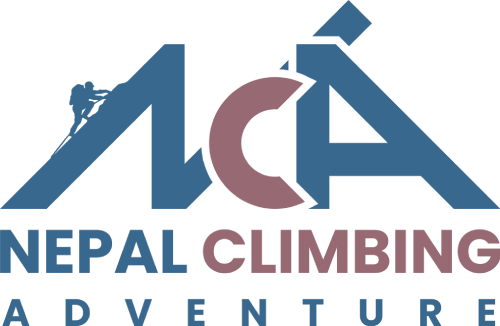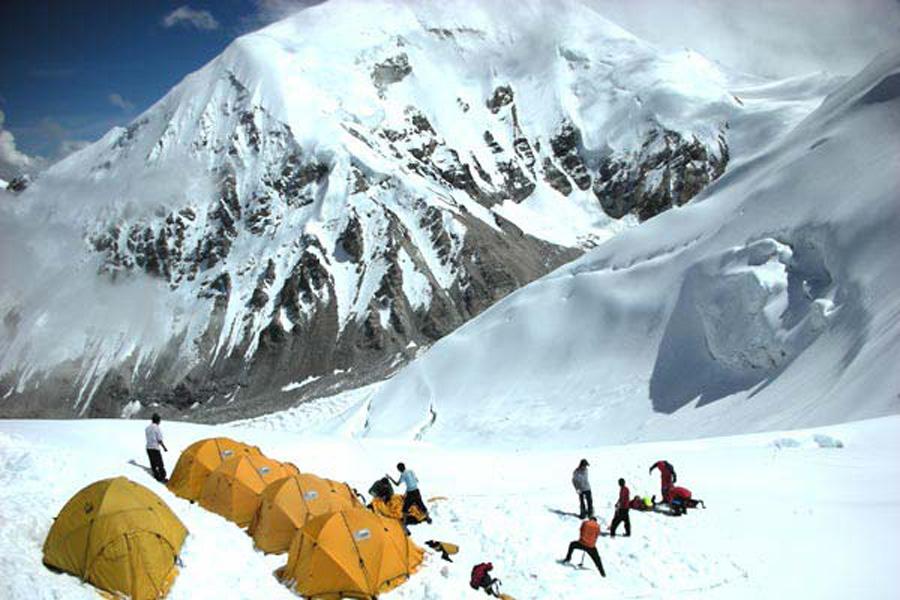Cho Oyu Expedition is not only just mountain climbing but also a cultural excursion from the scenic hilly region of Nepal to the desert-like valleys of Lhasa. This is a lifetime expedition experience.
Overview:
Cho Oyu Expedition dominates the skyline at 8201m above sea level and is the sixth highest mountain in the world. It is not only an 8000-meter mountain but also a magnificently beautiful mountain. Cho Oyu Peak 8201M Expedition brings an adventure opportunity to climb to the top of this beautiful mountain in the Himalayas.
In the Tibetan language, Cho Oyu translates to “Turquoise Goddess”. The mountain lies in the center of the Tibetan and Nepalese Himalayas. Mt. Cho Oyu radiates its beauty in such a way that it undermines other towering Himalayan Peaks like Everest, Ama Dablam, and others that neighbor it. Every year this Cho Oyu Peak 8201M Expedition brings mesmerizing energy calls for thousands of adventurers and mountaineers from all around the globe.
Mount Cho Oyu was first summited in 1954 by Herbert Tichy, Sepp Jocher, and Pasang Dawa Sherpa Lama. Among all the fourteen highest peaks that tower over 8000m, Cho Oyu is one of the easiest peaks to climb. Cho Oyu Mountain Expedition is ideal for novice climbers who are keen to learn the art of mountain climbing. It can also be an ideal preparation expedition for your future expeditions like Everest Expedition.
The summit, though physically demanding, is not technically challenging due to the presence of fixed lines. It offers one of the easiest and safest Cho Oyu Climbing Experience in the Himalayas with the highest chance of summit. This straightforward Cho Oyu Climbing Expedition experience is also suitable for climbers looking for a quick adventure.
The months between March to May during Spring are the best months for this Cho Oyu Peak Climbing Expedition as it allows enough time for proper acclimatization, several returns to base camp as well as rest days for the perfect ascent.
Reasons Cho Oyu Expedition becomes an Experience
Nepal Climbing Adventure always strives to offer an adventure traveling experience that you can cherish. While this expedition is beautiful in its all essence, your experience of trekking there becomes even more beautiful with us.
By the time we take you to the base camp and bring you back, we take one step ahead to offer you a beautiful experience. We keep your safety and happiness is our top priority and you will experience the same during the trip.
Going on the Cho Oyu Expedition with us is traveling in safe hands.
Where is Cho Oyu Located?:
Cho Oyu is situated in the Himalayas, specifically on the border between Nepal and Tibet (China). It is part of the Mahalangur Himal subrange and stands as the sixth highest mountain globally, towering at 8,188 meters (26,864 feet) above sea level. The mountain is renowned for its stunning beauty, characterized by glacier-covered slopes and sharp ridges that challenge even the most experienced climbers. Its name, derived from Tibetan, translates to "Turquoise Goddess," a fitting description for the majestic peaks that shimmer under the clear Himalayan skies.
Cho Oyu Mountain Expedition location offers breathtaking views and is a significant draw for mountaineers and adventurers seeking to conquer its heights. The Nepalese side provides a relatively more accessible route, starting from the Everest Base Camp area, while the Tibetan side requires special permits and permissions due to its controlled access from China. The mountain's proximity to Mount Everest, Lhotse, and Makalu adds to its allure, forming part of the iconic landscape that defines the Everest region. Cho Oyu Climb Expedition is challenging yet accessible routes make it a popular choice for climbers aiming to summit one of the world's tallest peaks amidst the awe-inspiring grandeur of the Himalayas.
Cho Oyu Climbing History:
Cho Oyu, standing at 8,188 meters (26,864 feet), is the sixth highest mountain in the world and lies on the border between Nepal and Tibet. Its name translates to "Turquoise Goddess" in Tibetan, reflecting the stunning glacier-covered peaks and the vibrant hues seen from afar. The mountain has a rich climbing history, with its first successful ascent achieved on October 19, 1954, by an Austrian expedition team led by Herbert Tichy, Joseph Jöchler, and Sherpa Pasang Dawa Lama.
Since then, Cho Oyu has become a popular destination for mountaineers seeking to summit one of the fourteen 8,000-meter peaks. Its relatively straightforward routes and lower technical difficulty compared to other nearby giants like Everest make it an attractive challenge for climbers of varying skill levels. The mountain's accessibility from both Nepal and Tibet adds to its allure, with climbers often choosing between the South-West Ridge from Nepal or the North-West Ridge from Tibet.
Best Time for Cho Oyu Expedition:
The best time for Cho Oyu Climbing Expedition is crucially determined by the seasonal weather patterns in the Himalayas. Generally, the best windows are during the spring (April to May) and autumn (September to October) seasons. These periods offer the most stable weather conditions, with clear skies and lower chances of precipitation, which are essential for safe and successful climbing.
During the spring months of April and May, climbers experience relatively warmer temperatures and longer daylight hours. This makes it easier for them to acclimatize to the high altitudes and increases their chances of reaching the summit. The weather is generally more predictable, with minimal snowfall and reduced risk of avalanches, creating safer climbing conditions.
Autumn, from September to October, is another excellent time for this expedition. While temperatures can be colder compared to spring, the weather remains stable and clear. The skies are typically crisp and visibility is excellent, offering stunning panoramic views of the surrounding Himalayan peaks. The Cho Oyu Climbing Route is less crowded during autumn compared to the peak spring season, allowing climbers to enjoy a more serene and solitary experience on the mountain.
Both spring and autumn seasons avoid the monsoon rains and harsh winter conditions that can make climbing Cho Oyu exceedingly challenging and dangerous. Choosing between these two seasons often depends on personal preferences regarding temperature, crowd levels, and desired climbing experience. Ultimately, the best time for this expedition balances favorable weather conditions with safety considerations and individual climbing goals, ensuring a memorable and rewarding adventure in one of the world's highest mountain ranges.
Cost for Cho Oyu Expedition:
The cost of this expedition can vary widely depending on several factors such as the route chosen, the guiding services, equipment, permits, and the duration of the expedition. Generally, a fully-supported expedition with experienced guides and all necessary equipment can range from $30,000 to $40,000 per person. This Cho Oyu Expedition Cost typically covers logistics like transportation to base camp, accommodation, meals, climbing permits, and the services of experienced guides who ensure safety and support throughout the climb.
Additional costs may include personal gear such as high-altitude clothing, climbing equipment like ropes and harnesses, and travel insurance, which is essential for such high-risk endeavors. Some expeditions offer varying levels of support and luxury, which can affect the overall cost significantly. It's crucial for climbers to budget for unforeseen expenses and to choose a reputable expedition operator with a proven track record in mountaineering and safety to maximize their chances of a successful and safe ascent of Cho Oyu, the sixth highest mountain in the world.
Why Climb Cho Oyu?
Climbing Cho Oyu, the sixth highest mountain in the world at 8,188 meters (26,864 feet), attracts mountaineers for several compelling reasons. First, its altitude and technical challenges provide an excellent training ground for those aiming to summit even higher peaks, like Everest. The ascent, while demanding, is considered more achievable than other 8,000-meter peaks due to its less steep terrain and fewer technical obstacles, making it a popular choice for climbers looking to advance their skills.
Cho Oyu's location in the heart of the Himalayas offers breathtaking views of neighboring peaks, including Everest and Lhotse, adding to the allure for adventurers and photographers alike. The journey to Cho Oyu often involves crossing remote and beautiful landscapes, providing a profound wilderness experience. Many climbers are drawn to the cultural richness of the region, interacting with local Sherpa communities and learning about their traditions.
Cho Oyu's accessibility from both Tibet and Nepal offers flexibility in expedition planning, accommodating different preferences and logistical considerations for climbers. Scaling Cho Oyu presents an opportunity for scientific research, particularly in high-altitude physiology and glaciology, due to its challenging yet manageable conditions. Finally, standing atop Cho Oyu represents a significant personal achievement for climbers, marking their entry into the elite ranks of those who have conquered one of the world's highest and most iconic peaks.
Cho Oyu How long to climb?
Climbing Cho Oyu, the sixth highest mountain in the world, typically takes around 6 to 8 weeks. This timeframe includes various stages essential for acclimatization and climbing. The expedition begins with a trek to Base Camp, situated at approximately 5,300 meters (17,388 feet) above sea level. This initial Cho Oyu Trek usually takes about a week, allowing climbers to adjust to the altitude gradually.
Once at Base Camp, climbers undergo a series of rotations between different camps at increasingly higher altitudes. These rotations are crucial for acclimatizing the body to reduced oxygen levels found at high altitudes, helping to prevent altitude sickness and preparing climbers for the final ascent. Climbers progress through Camp 1 (6,400 meters / 21,000 feet), Camp 2 (7,000 meters / 23,000 feet), and Camp 3 (7,400 meters / 24,300 feet), establishing higher camps and stocking them with necessary supplies. The final push to the summit, which stands at 8,188 meters (26,864 feet), usually takes place in a single day from one of the Cho Oyu High Camp Expedition.
Weather conditions play a significant role in the duration of the climb, as climbers must wait for suitable windows of stable weather to attempt the summit. The descent to Base Camp typically takes several days, allowing for gradual descent and recovery. Climbing Cho Oyu requires careful planning, physical conditioning, and a significant commitment of time and resources due to its high altitude and challenging terrain.
Cho Oyu Route:
Cho Oyu, the sixth highest mountain in the world at 8,188 meters (26,864 feet), offers several climbing routes. The most popular and frequently used route is the Northwest Ridge, which is known for its relatively moderate technical difficulty compared to other 8,000-meter peaks. Climbers typically start from Tibet's Tibetan Plateau, navigating through advanced base camps and establishing higher camps as they ascend. The route involves negotiating crevasses, ice cliffs, and seracs, with the final push to the summit requiring careful planning and acclimatization due to the high altitude and challenging weather conditions. Cho Oyu's accessibility and breathtaking views make it a sought-after peak for mountaineers aiming to conquer one of the world's tallest mountains.
Cho Oyu South Route:
Cho Oyu's South Route is a popular ascent path on the world's sixth-highest mountain, located in the Himalayas on the border between Nepal and Tibet. Known for its accessibility compared to other 8,000-meter peaks, the South Route offers climbers a challenging yet technically manageable ascent. The route begins from the Tibetan side, typically starting with a drive from Kathmandu to the base camp. From Cho Oyu High Camp Expedition climbers proceed through progressively navigating crevasses, ice fields, and steep sections.
Unlike some of its neighboring peaks, Cho Oyu's South Route is renowned for its relatively safer conditions, attracting both experienced climbers and those aiming for their first 8,000-meter summit. The climb usually takes several weeks, allowing for acclimatization and weather considerations. The final push to the summit involves a steep, snowy ridge leading to breathtaking views from the top, including vistas of Everest to the north and the expansive Tibetan Plateau to the north. Overall, Cho Oyu's South Route combines adventure with strategic planning, offering a memorable and achievable Himalayan climbing experience for enthusiasts from around the world.
Cho Oyu North Route:
Cho Oyu, standing at 8,188 meters (26,864 feet), is the sixth highest mountain in the world and lies on the border between Nepal and Tibet. The North Route of Cho Oyu is a popular ascent path, known for its relatively less technical challenges compared to other high peaks in the region like Everest. This route starts from Tibet's side of the mountain and follows a gradual incline up the northwest face. Climbers typically establish base camps at various levels, using them to acclimatize to the altitude and prepare for the higher reaches.
The North Route offers stunning views of the Tibetan Plateau and neighboring peaks, making it a favorite among mountaineers seeking a challenging yet manageable expedition. Despite its accessibility compared to other peaks in the region, Cho Oyu's high altitude demands careful planning, experienced guides, and a strong physical condition from climbers attempting to summit. The North Route's popularity stems from its scenic beauty, manageable technical difficulty, and the opportunity it provides for climbers to experience the thrill of high-altitude mountaineering in the heart of the Himalayas.
Cho Oyu Summit Success Rate:
Cho Oyu, boasts a relatively high summit success rate among the world's highest peaks. Approximately 50% of climbers attempting Cho Oyu successfully reach the summit. This success rate is often attributed to the mountain's less technical climbing routes compared to other Himalayan giants like Everest. Cho Oyu's accessibility and less challenging terrain make it a popular choice for climbers aiming to conquer one of the "eight-thousanders" without as much technical difficulty, though climbers still face altitude challenges and variable weather conditions typical of high-altitude climbs.
Cho Oyu Death Rate:
Cho Oyu, the sixth highest mountain in the world at 8,188 meters (26,864 feet), has a death rate that varies annually. On average, around 4 to 5 climbers lose their lives each year while attempting to summit. The cho oyu death rate include altitude sickness, falls, avalanches, and extreme weather conditions. Despite being considered one of the more accessible 8,000-meter peaks, the altitude and unpredictable nature of the mountain demand significant mountaineering expertise and preparation to mitigate risks effectively.
Cho Oyu Expedition Difficulty Level:
Cho Oyu, standing at 8,188 meters (26,864 feet), is renowned as one of the more achievable 8,000-meter peaks in the Himalayas, but it still presents significant challenges. Its accessibility and relatively less technical climbing compared to peaks like Everest make it a popular choice for mountaineers aiming to summit one of the world's highest mountains. However, despite its reputation as "easier" among the 8,000-meter peaks, Cho Oyu demands excellent physical fitness, technical climbing skills, and acclimatization due to its extreme altitude.
The cho oyu difficulty involves crossing glaciers, navigating crevasses, and enduring harsh weather conditions common to high-altitude climbs. Climbers often encounter unpredictable weather patterns, including high winds and sudden storms, which can pose serious risks. The route to the summit includes steep sections and icy slopes, requiring climbers to use ropes, crampons, and ice axes proficiently. The climb to Cho Oyu's peak involves several camps set at strategic points along the route, allowing climbers to acclimatize progressively. This acclimatization process is crucial for adapting to the thin air and reducing the risk of altitude-related illnesses.
Cho Oyu Climbing Permit:
Climbing Cho Oyu requires obtaining a climbing permit, which is regulated by the respective authorities of Nepal and China/Tibet (depending on the route chosen). Climbers need to be part of an organized expedition team that has secured permission from the Nepalese government through the Department of Tourism. This team must submit various documents including a detailed itinerary, proof of insurance, and payment of necessary fees.
The Cho Oyu Climbing Permit fees vary depending on the season and the number of climbers in the team. It is generally higher during the peak climbing seasons of spring (April-May) and autumn (September-November). The permit fees contribute to the maintenance of climbing routes, environmental conservation efforts, and local community development projects.
Once the expedition is approved and the permit is issued, climbers can proceed with their journey to Cho Oyu base camp Expedition. Obtaining a Cho Oyu Climb permit for Cho Oyu involves careful planning, adherence to regulations, and respect for the natural environment. It offers climbers an unforgettable experience amidst the grandeur of the Himalayas, coupled with the thrill and challenges of high-altitude mountaineering.
Gear and Equipment for Cho Oyu Expedition:
Preparing for a Cho Oyu expedition requires careful consideration of essential gear and equipment to ensure safety and success in scaling the world's sixth highest peak. Firstly, clothing suitable for extreme cold conditions is crucial, including thermal base layers, insulated jackets, waterproof outer shells, and durable mountaineering boots with crampon-compatible soles. High-altitude trekking pants and gaiters are also necessary to protect against snow and ice.
For personal Cho Oyu Climbing Gear, a quality sleeping bag rated for sub-zero temperatures and a four-season tent capable of withstanding harsh mountain weather are essential. Additionally, a comfortable and reliable backpack with a capacity of at least 70 liters is needed to carry gear and supplies during the climb. During Cho Oyu Trekking, climbers must also carry a headlamp with extra batteries, trekking poles for stability, and a multi-tool or knife for utility purposes.
For Cho Oyu Ascent and glacier, the technical equipment includes a climbing harness, ropes, carabiners, ice axes, and crampons are suitable. A helmet is essential for protection against falling debris and accidents. For communication and navigation, a satellite phone or communication device, along with GPS equipment and maps, are vital for staying connected and navigating the challenging terrain.
Health and safety items such as a comprehensive first aid kit, high-altitude medications, sunscreen with high SPF, and sunglasses with UV protection are critical. Adequate nutrition and hydration are maintained with a portable stove, lightweight cooking utensils, and a sufficient supply of energy-rich food and clean water. Finally, climbers should pack lightweight and compact gear to minimize weight without compromising on safety or functionality, ensuring a successful and enjoyable Cho Oyu expedition.
Cho Oyu Weather:
Cho Oyu, located in the Himalayas, experiences a challenging and unpredictable weather pattern typical of high-altitude mountain ranges. Situated on the border between Nepal and Tibet, Cho Oyu encounters severe cold throughout the year, with temperatures often dropping well below freezing, even during the summer months. The mountain is known for its frequent snowfall and strong winds, especially in the winter and early spring. These weather conditions pose significant challenges to climbers attempting to summit Cho Oyu, requiring careful planning and preparation to navigate the harsh environment safely.
During the Cho Oyu Climbing Season, which typically spans from April to May and again in September to October, the weather can vary widely, ranging from clear skies to sudden storms. Climbers must be vigilant and responsive to weather forecasts, as conditions can change rapidly, affecting visibility and safety on the mountain. The variability in Cho Oyu's weather demands climbers to be well-equipped with appropriate gear for extreme cold and capable of adjusting their plans based on real-time weather updates to ensure a successful and safe ascent of this majestic Cho Oyu Peak.
Detailed Cho Oyu Expedition Itinerary:
Day 01: Arrival at the Kathmandu Airport
A designated individual will welcome you upon arrival in the Tribhuvan International Airport. You will be escorted to your hotel and will meet your travelling companions and a welcome dinner will be organized in the evening where you will be served with original Nepali cuisine and introduced to Nepali culture.
- Accommodation: Hotel?
Day 02 - 03: Sightseeing and necessary preparations in Kathmandu
Today we spent our day sightseeing and exploring in Kathmandu. The sightseeing involves UNESCO world heritage sites such as Swayambhunath Temple, Pashupatinath Temple, Kathmandu Durbar Square and many more. Back at the hotel you will be briefed on the set itinerary to make necessary trip preparations along with Chinese Visas and paper works.
- Accommodation: Hotel
- Meal: Breakfast
Day 04: Flight to Lhasa
Today we will be taking an early flight to Lhasa in Tibet. The flight is filled with soothing views of the Himalayan peaks such as Everest, Kangchenjunga and Makalu. Upon your arrival in Lhasa you will be introduced to trek guides and porters. You will be escorted to your hotel in Lhasa for overnight stay.
- Accommodation: Hotel
- Meal: Breakfast, Lunch and Dinner
Day 05 - 06: Lhasa Sightseeing and Acclimatization
This is an important phase of this trip where we acclimatize ourselves to the weather and the high altitude. To further acclimatise we explore and discover various landmarks of Lhasa such as the Dalai Lama’s Potala Palace.
- Accommodation: Hotel
- Meal: Breakfast, Lunch and Dinner
Day 07: Drive to Shigatse
Today we drove to Shigatse, Tibet’s second largest city. We drive along the banks of the TsangPo river. The trail drives up-stream further to the southwest through barren desert-like valleys. We reached Shigatse where we spent the night at a local hotel.
- Accommodation: Hotel
- Meal: Breakfast, Lunch and Dinner
Day 08: Drive to Xegar
We drive along the Tibetan highway filled with the panoramic views of Himalayan Massifs including Everest. Once in Xegar we will pay a visit downtown of Xegar as well as a monastery at the hilltop. We stayed overnight at a hotel outside of Xegar.
- Accommodation: Hotel
- Meal: Breakfast, Lunch and Dinner
Day 09: At Xegar for acclimatisation
Today is acclimatization day in Xegar. In order to adapt ourselves to the height of Chinese Base Camp we visit the main town of Xegar. We will also be hiking up the hilltop monastery to further accustom ourselves to the cold environment.
- Accommodation: Hotel
- Meal: Breakfast, Lunch and Dinner
Day 10: Arrival at Chinese Base Camp
The trip includes further drive up to the Chinese Base Camp. The trail drives further south involving a bumpy track before descending down to Cho Oyu
- Accommodation: Camping
- Meal: Breakfast, Lunch and Dinner
Day 11: At Chinese Base Camp for acclimatisation
Today we make further preparations in the Chinese Base Camp. In the afternoon we load our equipment and gears on the yaks. The next day the yaks will carry our loads to the Cho Oyu base camp expedition.
- Accommodation: Camping
- Meal: Breakfast, Lunch and Dinner
Day 12 - 15: Trek to Cho Oyu Advance Base Camp
The trek resumes along the long valley up to the Cho Oyu Advance Base camp. The next 3 days we will spend it as acclimatization days in camps at 5200 and 5450 meters before reaching the base camp. In the afternoon we will be organizing our climbing gears and performing climbing practices.
- Accommodation: Camping
- Meal: Breakfast, Lunch and Dinner
Day 16 - 40: Climbing Period. Ascent of Cho Oyu (8201 meter)
On the first day we will try to ascent the lower part of the mountain. The climb will be further dictated by the weather conditions of the mountain before returning back to the base camp. We will further climb higher with proper acclimatization. The climb will occur from the north-west face of Cho Oyu. We reached Camp 1 (6400m) which is 6-8 hours away from Gyabrag Glacier. A snow ridge from Camp 1 follows a steep climb to reach Camp 2 at 7000m. From Camp 2 the climb is easy enough to reach Camp 3 at 7400m. These camps will act as resting stops before the summit. At the summit we reward ourselves with the glorious view that surrounds us. After spending quality time we descend back to the Base Camp by day 40 following the same path.
- Accommodation: Camping
- Meal: Breakfast, Lunch and Dinner
Day 41: Return trek to road-head and drive to Gyirong
We will return to the road-head with the yaks carrying our loads. The trek involves a drive along the Tibetan Highway to Gyirong.
- Accommodation: Guesthouse
- Meal: Breakfast, Lunch and Dinner
Day 42: Drive to Kathmandu (Nepal)
Leaving Gyirong we crossed the border into Nepal. The drive to Kathmandu is a full day from here passing Syabrubesi. Once back in Kathmandu you will be escorted to your hotel.
- Accommodation: Hotel
- Meal: Breakfast and Lunch
Day 43: Kathmandu
Today we will celebrate our achievement of our expedition during dinner and treat ourselves with much needed rest. You can spend the rest of the day exploring and sightseeing in various parts of the valley. You can also spend a day by shopping to remember and reflect upon your visit to Nepal.
- Accommodation: Hotel
- Meal: Breakfast
Day 44: Departure
On this day you are free to do as you please until departure. The day can be spent by sightseeing or by taking the day off to rest. A designated individual will drop you at Tribhuvan International Airport as per your flight schedule. Farewell.
- Meal: Breakfast
What is included?
- All types of organizational requirements
- All trekking and climbing paper works and permits
- All airport and hotel transfers
- Welcome and farewell dinner
- Flight to Lhasa and back
- Accommodation and meals during the whole of the expedition
- Government and local taxes
- Reference notes to plan your trip
- An experienced English speaking climbing guide, assistant climbing guide, Sherpa porters including their salary, insurance, food, lodging and all equipments
- A comprehensive medical kit
- Facilities of Email and satellite phones in base camp
- Necessary oxygen bottles
- Written and photo internet dispatches to send your progress to your family
What is not included?
- Nepal and China Visa fee(bring small denomination cash USD and passport size photographs)
- International airfare
- Excess baggage charges
- Extra night accommodation apart from the schedule due to any reasons
- Lunch and evening meals in case of early return than the scheduled itinerary
- Travel and rescue insurance
- Charges of Email and satellite phones
- Charge for extra Sherpa porter (if required)
- Personal expenses
- Tips for climbing guide and Sherpa
There are a number of things that you need to keep in mind if you ever plan for your vacation. Because you want to make the most out of your limited time, it is truly a hectic job for you to find a trustworthy and experienced traveling companion. With Nepal Climbing, you have your problem solved already as we are one of the leading Trekking and Mountaineering organizations in Nepal and have been providing first class service in several travelling packages across the country for many years.
We prioritize your satisfaction and safety
At Nepal Climbing Adventure, our ultimate objective is to arrange the programs for you to make the most out of your valuable time. We value your satisfaction, adventure, amusement and safety. Regardless of whether you are searching for stunning perspectives along the trekking trails in Himalayan mountain range or widely acclaimed, heavenly attractions with developed societies, our exposure and experience in travel business will help you ensure your requirements are met.
We have professional staffs and service
We trust that extraordinary staff lead awesome administration. That is the reason we are collaborated with experienced and eager individuals. We possess authorized and government certified guides who are very much furnished with broad learning of Nepali communities and traditions. They additionally have familiar English speaking abilities and hierarchical capacities to encourage all types trekking groups.
Responsible Tourism and social values
We are endeavoring to lessen the effect of tourism by guaranteeing our staff are very much aware of ecological issues. We are doing our best to create less waste as could be expected under the circumstances and make a point to reclaim non-compostable wastes. We outline our itineraries and work in the field guided by the standards of ecotourism and reasonable tourism. Moreover, all our staff have been given ecological preparing and are extremely aware to the eco-system we enter. Additionally, we are adhering to sustainable assets of energy. Our guides will share you the social values, culture and religious harmony for better understanding the groups you visit.
Customizable Service
Our promise is to provide you with the travelling packages customizable according to your demand fulfilling your budget criteria. So, we can facilitate a minimum of 2 individuals with a personalized service at a reasonable cost.
Online Payment
Or
WIRE TRANSFER
Bank Details:
Account Holder's Name: Nepal Climbing Adventure Pvt. Ltd.
Bank Name: Himalayan Bank Ltd.
Account Number: 01907449340018
Account Type: USD
Address: Thamel, Kathmandu, Nepal
SWIFT CODE: HIMANPKA
For more detail contact us:
Krishna Subedi (Chris Chhetri): +977 9851076791 (24/7, Call/Viber/Watsapp)
We recommend our guests have a valid insurance policy before undertaking an adventure in Nepal Himalaya. During treks and expeditions, the insurance should cover for expenses such as air ambulance, helicopter rescue, and medical care. As an adventure operator, we (NCA), are not permitted to arrange or sell insurance packages here in Nepal as per the Government of Nepal.
Frequently Asked Questions (FAQs):
1. Cho Oyu in which country?
Cho Oyu is located on the border between Nepal and the Tibet Autonomous Region of China.
2. Who was the first person to climb Cho Oyu?
The first ascent of Cho Oyu was completed on October 19, 1954, by an Austrian expedition led by Herbert Tichy, along with Pasang Dawa Lama and Joseph Jochler.
3. How difficult is it to climb Cho Oyu?
Climbing Cho Oyu is moderately challenging, requiring strong physical fitness, high-altitude experience, and technical climbing skills. It's considered one of the more accessible 8,000-meter peaks for experienced mountaineers.
4. What are the interesting facts about Cho Oyu?
Cho Oyu, at a height of 8,188 meters, is the sixth tallest mountain in the world. In Tibetan, it is known as 'the turquoise goddess.' This stunning peak is located on the border between China and Nepal, only 12 miles west of Mount Everest.
5. What is the success rate of Cho Oyu?
Due to good route preparation, Cho Oyu has a relatively high success rate of approximately 50% among the Himalayan giants.
6. How safe is Cho Oyu?
The ease and safety of climbing Mount Cho-Oyu, depend on factors such as the climber's age, physical fitness, previous climbing experiences, weather, and climbing season.
7. Can you see Everest from Cho Oyu?
Climbing one of the highest mountains in the world has its rewards. And if you are fortunate enough to reach the summit, you will be rewarded with the most breathtaking view of Mt. Everest and the surrounding Himalayas.
8. How many people have climbed Cho Oyu?
As of recent records, over 4,000 climbers have successfully summited Cho Oyu, which remains a popular peak among mountaineers . Cho Oyu difficulty is relatively manageable compared to other 8,000-meter peaks.
9. How far is Cho Oyu from Everest?
Cho Oyu is located approximately 20 kilometers (12.4 miles) west of Mount Everest on the Nepal-Tibet border. Both peaks are part of the Mahalangur Himalayan range in the Himalayas.





















 Chris Chhetri
Chris Chhetri